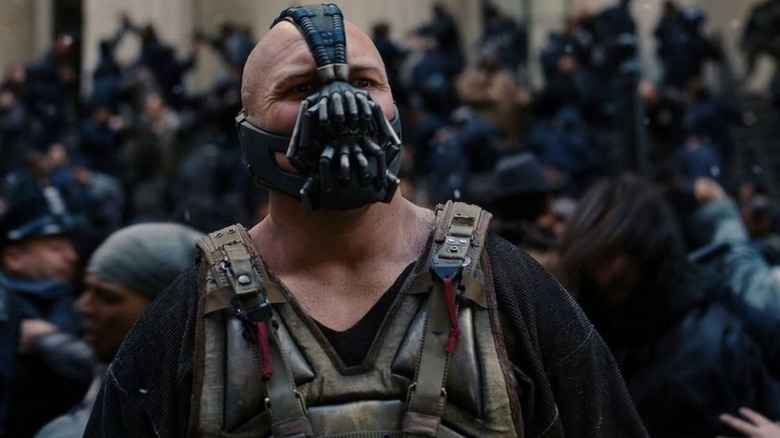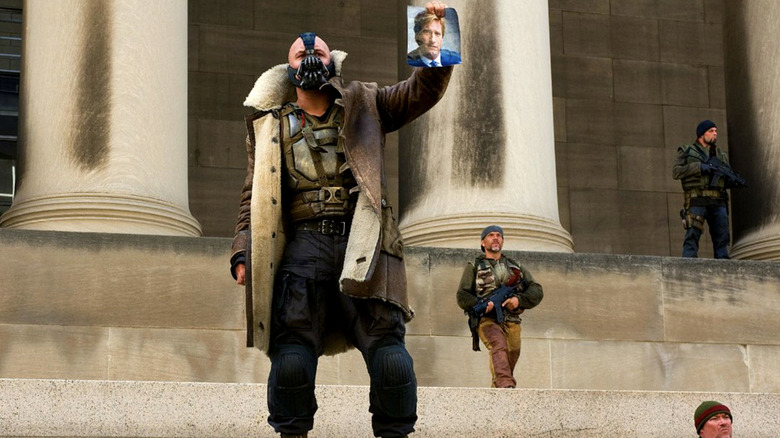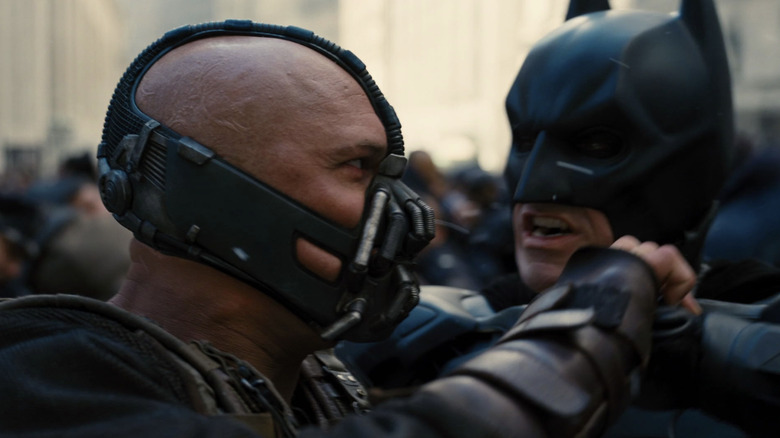Bane's Mask In The Dark Knight Rises Hints At An Unseen Part Of The Character's Past
Before being portrayed by Tom Hardy in "The Dark Knight Rises," the only other live-action Bane that existed was the cartoonish version that appears in "Batman & Robin." There's always been a fine line between cool and cheesy when it comes to adapting comic book costumes to the big screen. Luckily, the next time Bane appeared to face his nemesis, it wouldn't be looking like a luchador who mistakenly wandered in front of the camera. For the big screen revival of the character, Christopher Nolan relied on two of his defining characteristics: his immense physical strength and fear-inspiring mask.
But the director would also change key pieces of Bane's backstory to fit into the narrative world of his Batman trilogy, much of which is not directly mentioned in the plot of "The Dark Knight Rises." By the end of the film, plenty of what the audience knows about the villain's backstory can only be guessed at, including the origin of his mask and whether or not it's the source of his exceptional endurance as it is in the comics. Leave it to Nolan to inject some choice ambiguity wherever he can find the space for it. However, that hasn't kept him or others from clarifying little bits and pieces of Bane's past.
Christopher Nolan tweaks a supervillain origin story
In the comics, Bane wears the mask to give himself regular injections of a toxin known as Venom, which lends him incredible power but can also debilitate him if it's not taken in a timely manner. He also spent his youth in a prison, which is where he first donned the mask. But Nolan's film differs from the comics in one important way. "Bane is someone ravaged by pain from a trauma suffered long ago," the director said according to Batman News. "And the mask dispenses a type of anesthetic that keeps his pain just below the threshold so he can function."
Costume designer Lindy Hemming went into further detail, explaining that the pipes in his mask "go back along his jawline and feed into the thing at the back where there are two canisters," which are presumably filled with the substance, keeping the agony at bay. What's ironic is that CIA agent Bill Wilson (Aidan Gillen) makes that very assumption when he asks Bane if taking off the mask will kill him and the latter replies it would be "extremely painful."
The reason Bane's mask dispenses an anesthetic instead of Venom is revealed by Miranda Tate, a.k.a. Talia Al-Ghul (Marion Cotillard), at the end of the film. Upon helping her escape the prison after her mother's death, Bane is brutally beaten by the prisoners and attempts to heal him lead to the development of chronic pain. In a lot of ways, Nolan's version of the character better emphasizes the inherent tragedy at the center of his story than previous ones. And he does so while also grounding the character in a far more realistic manner that's no less menacing than the source material has always been.
How getting rid of Venom was an improvement on the character
Nolan's backstory for Bane is actually just as unfortunate as the one in the comics, especially since the Venom experiment that gave him his power is conducted against his will. As a result of that cruelty and the years of having to survive in a prison as a child, it's no surprise that he turns into a supervillain. But perhaps what makes Bane's path in "The Dark Knight Rises" slightly more unfortunate is the goodwill it's inspired by, which is in sharp contrast to the horrific acts of violence he executes throughout the film.
As reported by Batman News, Hardy doesn't mince words when calling his character "brutal" and a "wrecking ball." Whoever he was before he met Talia is a mystery, but for a split second in his past, he was just a man choosing to protect a child at the expense of his own life. But Venom was always just a symbol of both Bane's pain and his reliance on it to keep himself from ever being that helpless again. In "The Dark Knight Rises," his fanatical devotion to Talia is what pushes him to keep taking the anesthetic and keep committing atrocities. Bane accomplishes his feats via his exceptional will and grandiose vision — not some drug — which is just as frightening and dangerous as superhuman strength.


